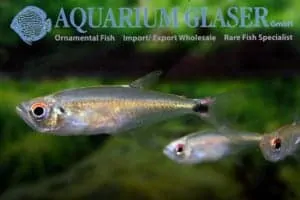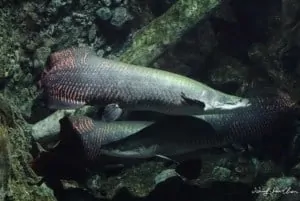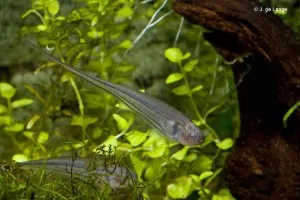Hypancistrus zebra – Zebra Pleco – L046
This wonderful armored catfish has led to a real craze among aquarium enthusiasts. Thanks to its striped pattern, its small size, and its peaceful character, this beautiful fish has become an indispensable part of our hobby. In 1991 this fish was described by Isbrücher and Nijssen. Soon this beautifully drawn Loricariidae made many hearts beat faster. Time to put the Hypancistrus zebra – Zebra Pleco – L046 in the spotlight!
Hypancistrus zebra has its origin in the Rio Xingu in Brazil. In that river, the pH is between 6 and 7.5 with a temperature that fluctuates between 26 and 30 degrees Celsius during the year. There is a high content of absorbed oxygen in the water. This river is dotted with rocks of all sizes, with fine sand in between. The Hypancistrus zebra lives in the deeper waters where it hides in narrow crevices and caves. The current in these waters is on average around 2 to 3 knots!
Diet
In the wild, the Zebra Pleco feeds on all kinds of insects (larvae), small shrimp, fruit, and dead meat. The Hypancistrus zebra uses the current to get its food. It hides under a rock or piece of wood, waits for its prey (for example, a small crustacean), and pounces on its prey if it is close enough. The fish will quickly return to its hiding place, dragging the prey under its body, to enjoy its well-deserved meal in peace.
The Aquarium
The L046 is easy to keep in the aquarium. A tank of 80 centimeters with a capacity of around 100 liters is sufficient for a group of 6 to 7 of these fish. The male of the highest rank (the alpha male) will always eat first. If the tank is too small, or the needs of these fish have not been taken into account, that male will not tolerate any other fish in the feeding area. It is therefore crucial that the layout of the (breeding) tank matches the situation in the L046’s natural biotope as closely as possible. This means that you should place as many dark stones as possible in the aquarium, in such a way that there are many cracks and holes for the fish to hide in.
Each male defends his territory, so it is also important to divide the tank well with good hiding places. Fights between males often lead to the death of the weaker fish!
Sexual Dimorphism
The difference between males and females is clearly visible from about 6 centimeters. First, there is a difference in build. Males have an angular build, females are rounder in shape. In addition, the males have long odontes on their gills. Females also have this but to a lesser extent. Males also sometimes carry these odontes on the pectoral fins. Furthermore, males are often darker, black seems to be more present than white.
Breeding the Hypancistrus zebra – Zebra Pleco – L046
Breeding the Zebra Pleco is relatively easy. The Hypancistrus zebra has been bred under the most diverse conditions, even in hard water with a pH of 8, this fish lays its eggs. Just one male and one female are not enough for breeding this fish. It takes an entire colony to get the best results. We assume that ideally there are more females than males in the breeding tank, for example, 4 females and 3 males. For many people, this is reason enough not to start breeding this fish, given the hefty prices that are asked for these fish, especially for adults that you desperately need for breeding.
Diet when breeding
Four factors, in particular, are of great importance for successful breeding. First, the food must consist of live bloodworms, brine shrimp, or possibly young fire shrimp. Feeding needs to be varied and sufficient, which is not always an easy task as the L046 competes poorly for food with other fish. For this reason, it is also advisable not to place other fish species in the (breeding) tank, so you will need a separate species-only tank!
Current
Second, a strong current is very important, as the Rio Xingu is a fast-flowing river. A filter volume of 10 times the net content per hour is not an exaggeration at all. In fact, it is even advisable to make use of flow pumps that pump the water in the tank another 10 times per hour!
Breeding caves
Then it is the turn of the breeding caves. The diameter and length of the breeding caves are very important here, and the positioning of these breeding caves also plays a role. A breeding cave must be just wide enough that the male can block the exit of this breeding cave with his head, and at least as long as the fish itself is. The back must be closed. It is always advisable to place more breeding caves than fish in the tank. It is also useful to use different sizes of breeding caves so that the fish can choose the most suitable breeding place themselves. There should be some flow along the front of the laying tube. Not directly in the tube, but just so that a little water flows through the tube. This is thought to help the male keep his nesting site clean and hatch the eggs.
The spawn
Finally, the fish should be stimulated to spawn. I will briefly describe one of the most commonly used ways to do this. The fish are well fed and the females have nice round bellies. The temperature should be around 28 degrees Celsius. Now turn off the heating and lower the temperature to 22 degrees over two days. Don’t do this too fast! In this cool period, you stop feeding for about 5 days. The fish can tolerate this, if well conditioned. After this, the temperature rises again, about 1 degree per day and you start feeding enough live food again. You continue with this until the temperature is 30 degrees Celsius. Then you change 50% of the water with slightly cooler water, about 27 degrees Celsius.
With a bit of luck, the Zebras Plecos will spawn, usually, there are 10 to 18 eggs. From now on, the male takes on the role of father. He takes care of the eggs with his sucker mouth and eats the unfertilized eggs. He also fans the eggs with his fins, so that there is sufficient current along the eggs. The eggs hatch after 4 to 7 days, depending on water quality and temperature. The young Zebra Plecos have large yolk sacs that provide them with food for 10 to 15 days.
At this stage, the fry are very fragile and even small snails can cause fatal accidents. In this phase, clean, warm water with a lot of oxygen is very important. Feeding the fry can cause problems. A widely used product is Sera viformo. Pour the moisture from compressed red mosquito larvae over these food tablets and let it soak in. In this way, there is good food and relatively few young zebras die. After a year or two, the L046 are adults with a length of around 6 or 7 cm. Now they can provide offspring themselves.
Hypancistrus zebra – Endangered in the wild
In the wild, the Hypancistrus zebra is in danger of extinction. In 2004, the export of these fish was banned by IBAMA because too many of these fish were caught for trade. Unfortunately, the government of Brazil plans to build dams in that part of the Rio Xingu where the L046 has its natural habitat. As a result, it is quite possible that the entire population living in the wild will become extinct. Fortunately, the L046 is now widely being bred in captivity. Especially in Germany progress is being made in this area.
However, the price of these fish is still very high. This is because, as you may understand after reading the above information, this fish is very scarce. Females are especially hard to come by. Prices vary enormously, juveniles often cost 70-100 Euros, whereas adult females can cost as much as 250 Euros! Unfortunately, there are also breeders who only think about the money, mainly from the Czech Republic. Here the shortage of L046 females is filled by placing L066, L173 or L333 females in the breeding tanks. This creates undesirable hybrid forms that are put on the market for little money, often for an amount of around 50 euros. Do not buy these hybrids! The introduction of these ‘fake zebras’ could cause valuable bloodlines of real zebras to be lost and could mean the definitive end of the species in the long run.
If you want to breed with the L046, be aware of the moral obligation that rests on you. So don’t do it so much for the money, but rather to contribute to helping this beautiful armored catfish survive!
Protected species and administration
Because the Hypancistrus zebra is now on the CITES list of protected animal species, you are obliged to keep some administration about the keeping and breeding of these animals. Ask your local authorities about the requirements! (for the Netherlands: RVO) When selling animals, a transfer form must be completed (for the Netherlands: this form).
Video
Authors
Tim
John de Lange
Copyright images
Tim
Marina Parha













Reviews
There are no reviews yet.